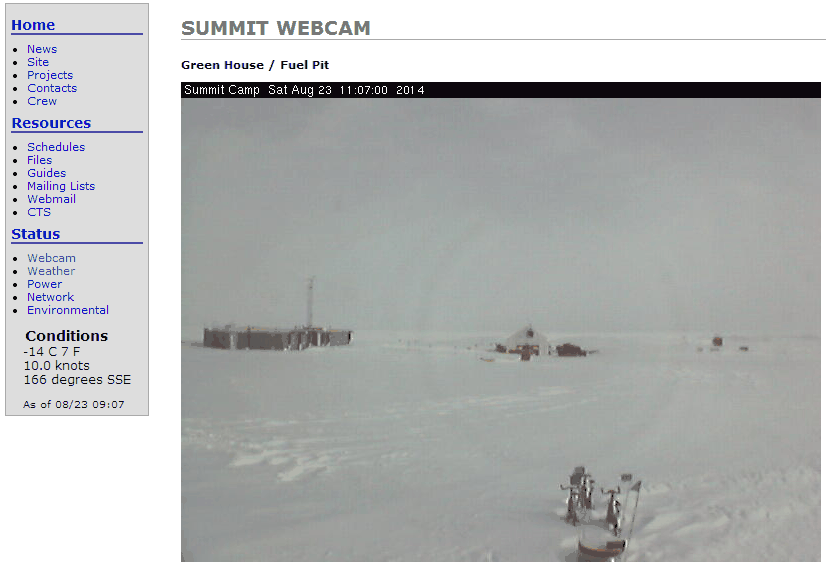At the end of another long hot summer in Greenland, the research station in the center of the ice cap is nearly buried in new snow which accumulated over the summer
Climate experts tell the press that Greenland is melting down, even though their own data shows a net surface gain of 300 billion tons of ice over the past year, and that more than 90% of the surface has gained ice.



Steve, if you please, a link to that data?
I have several times tried to engage people who claim Greenland or Antarctica is melting down, but I can Never get them to tell me how much new snow and ice is forming in the interior. They’ll admit to melting but not to accumulating. I’d like to be able to shove it (the actual data) in their faces.
http://beta.dmi.dk/en/groenland/maalinger/greenland-ice-sheet-surface-mass-budget/
Thank you. I was going to ask the same, and for the same reasons.
Thank you Sir!
Iceberg calving affects the net gain/loss which is the number oft quoted by AGW.
From the article: “Over the year, it snows more than it melts, but calving of icebergs also adds to the total mass budget of the ice sheet. Satellite observations over the last decade show that the ice sheet is not in balance. The calving loss is greater than the gain from surface mass balance, and Greenland is losing mass at about 200 Gt/yr.”
That has nothing to do with melt, and their figures are complete BS.
Increased calving rates usually mean the ice pack is expanding. If they were not expanding calving rates would slow to a point of no calving at all if continued long enough.
CryoSat satellite data on elevation change of Greenland ice shows a net annual decrease of 375 Gt during 2011-2014. See last image: http://www.bbc.com/news/science-environment-28852980
The 200 Gt/yr of lost ice is an average over recent years, the present situation is a relative gain of mass with respect to 2013 season.
This data agrees also with the stable/growing icecap in the entire Arctic in 2013 and this year, probably reflecting increased average cooling of the region.
The present trend is “upward” (ice accumulation), that’s what Steve’s post is saying, but their analysis is still based on the previous trend, which is *biased* because the trend started to change last year.
If they wanted to be perfectly honest, they should have mentioned that.
It will all come out in the wash Jan 2015 when there are whole year numbers to compare. I expect 2012 less than 2013 less than 2014, that would make a trend, if it occurs. Better to keep powder dry and not rely on year to month or recent months data.
Snowing there; arctic 10 day forecast gifs:
http://www.weather-forecast.com/maps/Arctic?symbols=none&type=prec
Yes, but Greenland isn’t only place expecting snow this weekend…
http://www.wunderground.com/news/first-snow-august-montana-glacier-national-park-20140822
Tiger can start his comeback with a good showing at the Greenland Open.
Reblogged this on wwlee4411 and commented:
Global warming and the melting of Arctic ice.
Hey! Where are the climate refugee huts?
That’s how the polar bears are hanging on…climate refugees are an acceptible seal substitues, according to the latest research by Erlich.
Ehrlich
There was fresh snow on some of the Scottish mountains the other day.
http://bprc.osu.edu/wiki/Greenland_Factsheet
Plenty of ice in Greenland. Ice-loss in Greenland is off my list of things to worry about.
http://notalotofpeopleknowthat.wordpress.com/2012/01/22/we-live-in-the-coldest-period-of-the-last-10-000-years/
Now it’s really off my worry list!
From the link,
“Temperatures in Greenland were about 1.5 C warmer 1000 years ago than now. “
The present “unprecedented” warming is 1.5 C *below* the MWP in Greenland and probably in the entire world, by a smaller amount, having in sight the predominant influence of NH temperatures over global averages. This is happening after 100 years of one of the strongest solar grand maximums of the Holocene,
https://pbs.twimg.com/media/BVIbFt7CMAAkts9.jpg
The general downward trend of global temperatures, spanning many centuries, is quite obvious.
The above Fig.3 is from the paper of Usoskin et al.,
“Grand minima and maxima of solar …” I. G. Usoskin,S.K.Solanki, and G. A. Kovaltsov (2007) : http://www.aanda.org/articles/aa/abs/2007/31/aa7704-07/aa7704-07.html …